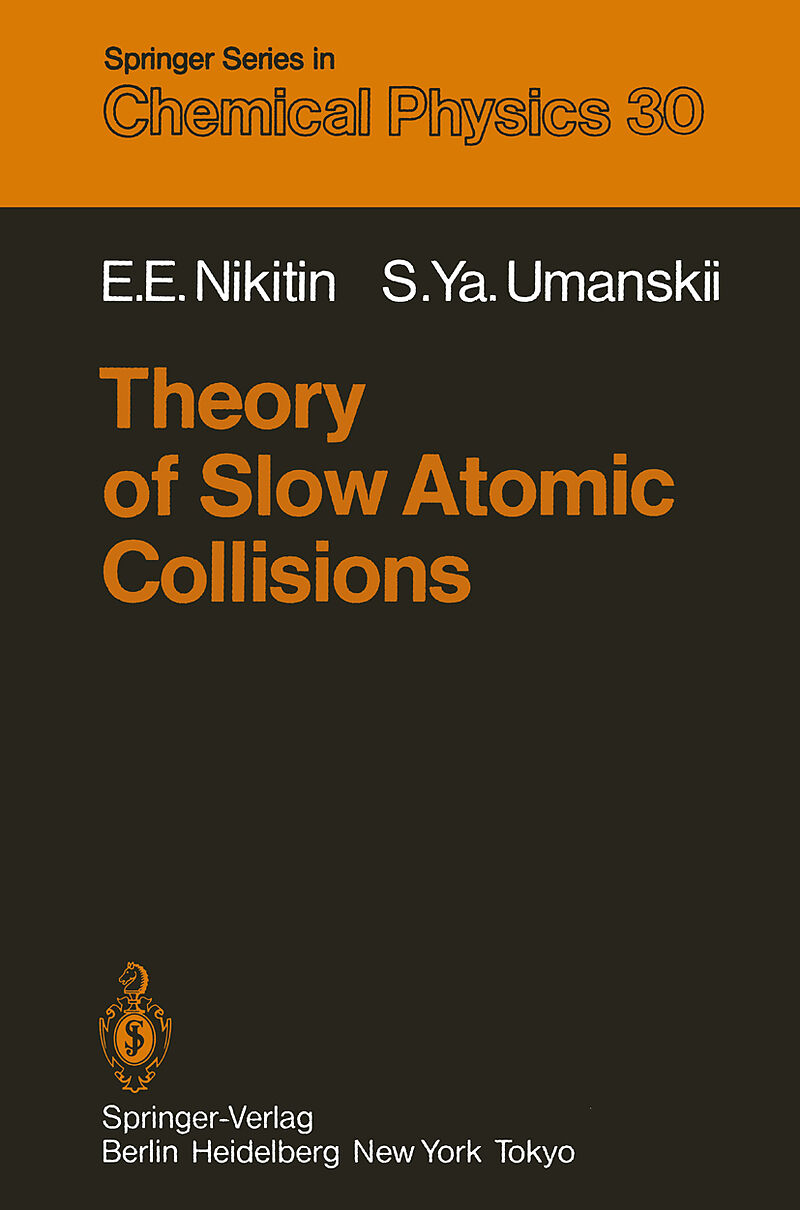Theory of Slow Atomic Collisions
Einband:
Kartonierter Einband
EAN:
9783642820472
Untertitel:
Springer Series in Chemical Physics 30
Autor:
S. Y. Umanskii, E. E. Nikitin
Herausgeber:
Springer Berlin Heidelberg
Auflage:
Softcover reprint of the original 1st ed. 1984
Anzahl Seiten:
452
Erscheinungsdatum:
22.12.2011
ISBN:
3642820476
The theory of atom-molecule collisions is one of the basic fields in chemi cal physics. Its most challenging part - the dynamics of chemical reactions - is as yet unresolved, but is developing very quickly. It is here a great help to have an analysis of those parts of collision theory which are already complete, a good example being the theory of atomic collisions in process es specific to chemical physics. It has long been observed that many notions of this theory can also be applied successfully to reactive and unreactive molecular collisions. More over, atomic collisions often represent a touchstone in testing approaches proposed for the solution of more complicated problems. Research on the theory of slow atomic collisions carried out at the Moscow Institute of Chemical Physics has been based on just these ideas. A general viewpoint concerning the setting up and representation of the theory came out of these studies, and appeared to be useful in studying complicated systems as well. It underlies the representation of the theory of slow atomic colli sions in this book.
Klappentext
The theory of atom-molecule collisions is one of the basic fields in chemi cal physics. Its most challenging part - the dynamics of chemical reactions - is as yet unresolved, but is developing very quickly. It is here a great help to have an analysis of those parts of collision theory which are already complete, a good example being the theory of atomic collisions in process es specific to chemical physics. It has long been observed that many notions of this theory can also be applied successfully to reactive and unreactive molecular collisions. More over, atomic collisions often represent a touchstone in testing approaches proposed for the solution of more complicated problems. Research on the theory of slow atomic collisions carried out at the Moscow Institute of Chemical Physics has been based on just these ideas. A general viewpoint concerning the setting up and representation of the theory came out of these studies, and appeared to be useful in studying complicated systems as well. It underlies the representation of the theory of slow atomic colli sions in this book.
Inhalt
1. Introduction.- 2. General Formulation of Scattering Problem Under Quasi-Classical Conditions.- 2.1 Scattering Amplitudes and Cross Sections.- 2.2 Scattering Equations.- 2.3 Collisions of Two Many-Electron Atoms.- 2.4 Integral Cross Sections for Isotropic Collisions.- 3. Diatomic Electronic States.- 3.1 Quantum Numbers and Wave Functions of a Free Atom..- 3.2 Quantum Numbers and Wave Functions of Diatoms.- 3.3 Adiabatic States, Diabatic States, and Correlation Diagrams.- 3.4 Coupling Between Electronic States. Selection Rules.- 4. Approximate Calculation of the Electronic States of Diatoms.- 4.1 Atomic Potential and Atomic Orbitals.- 4.2 Diatomic Interactions at Large Distances and the Heitler-London Approximation.- 4.3 Pseudopotential Method for Interatomic Interactions.- 4.4 Short-Range Atomic Interactions.- 4.5 Coupling Between Electronic States.- 5. Elastic Scattering.- 5.1 Quasi-Classical Scattering Amplitude.- 5.2 Quasi-Classical Scattering Matrix.- 5.3 Classical Scattering.- 5.4 Integral Cross Sections.- 5.5 Differential Cross Sections.- 6. Approximate Calculation of a Multichannel Quasi-Classical Scattering Matrix.- 6.1 Common-Trajectory Approach.- 6.2 Matching Approach.- 6.3 Perturbation Approach.- 7. Two-State Scattering Problem.- 7.1 The Two-State Model. Adiabatic and Diabatic Representations.- 7.2 Construction of the Two-State Quasi-Classical S Matrix by the Matching Method.- 7.3 Two-State Semiclassical Models.- 7.4 Differential Cross Sections and Deflection Functions.- 8. The Linear Two-State Landau-Zener Model.- 8.1 Formulation of the Model.- 8.2 Nonadiabatic Transitions Far from the Turning Point. Landau-Zener-Stueckelberg Solution.- 8.3 Nonadiabatic Transitions Near the Turning Point.- 8.4 Validity of Linear Model and of Analytical Expressions for Transition Probabilities.- 8.5 Cross Sections for the Linear Model.- 9. Nonlinear Two-State Models of Nonadiabatic Coupling.- 9.1 Exponential Model.- 9.2 Linear-Exponential Model.- 9.3 Other Nonlinear Models.- 10. Multistate Models of Nonadiabatic Coupling.- 10.1 Transitions Between Degenerate States.- 10.2 Transitions Between Highly Excited States.- 10.3 Generalizations of the Linear Model.- 11. Case Study Intramultiplet Mixing and Depolarization of Alkalis in Collisions with Noble Gases.- 11.1 Formulation of the M* X Scattering Problem.- 11.2 The Scattering Matrix.- 11.3 Transition Probabilities and Cross Sections for Isotropic Collisions.- A. Quantum Theory of Angular Momentum.- A. l Rotation Matrices and Spherical Functions.- A.2 Coupling of Angular Momenta, Clebsch-Gordan.- A.3 Matrix Elements of the Irreducible Tensor.- Operators.- References.

Leider konnten wir für diesen Artikel keine Preise ermitteln ...
billigbuch.ch sucht jetzt für Sie die besten Angebote ...
Die aktuellen Verkaufspreise von 5 Onlineshops werden in Realtime abgefragt.
Sie können das gewünschte Produkt anschliessend direkt beim Anbieter Ihrer Wahl bestellen.
Loading...
Die aktuellen Verkaufspreise von 5 Onlineshops werden in Realtime abgefragt.
Sie können das gewünschte Produkt anschliessend direkt beim Anbieter Ihrer Wahl bestellen.
| # | Onlineshop | Preis CHF | Versand CHF | Total CHF | ||
|---|---|---|---|---|---|---|
| 1 | Seller | 0.00 | 0.00 | 0.00 |
